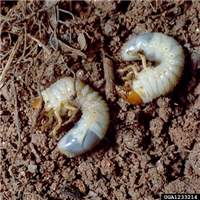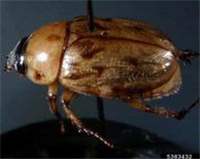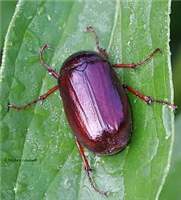Click on images to enlarge

White grubs of Phyllophaga species. ©Clemson University, USDA Cooperative Extension Slide Series, Bugwood.org

Adult scarab beetle of the genus Cyclocephala species. ©Charles Olsen, USDA APHIS PPQ, Bugwood.org

Adult of Phyllophaga species. ©Stephen Cresswell, American Insects Coleoptera Pages.
Summary
The term 'white grubs' refers to the larvae of scarab beetles of different genera that damage crops by feeding on root systems. This can lead to poor plant growth and sometimes plant death. Damage can be especially serious when the white grubs feed on young plants. Adults can also damage plants but damage caused by adults is rarely serious. The identification of any particular white grub species is likely to require a specialist.
Common Names
White grubs, annual white grubs, chafer beetles
Taxonomic Position
Phylum: Arthropoda; Class: Hexapoda (Insecta); Order: Coleoptera; Family: Scarabaeidae;Genera: white grubs are found in many genera in the family Scarabaeidae; among them Cyclocephala, Heteronychus, Eulepida and especially Phyllophaga.
Origin and Distribution
Scarab beetles and thus white grubs are found worldwide.
Description
There is a whole range of scarab beetles with larvae that are referred to as white grubs. The identification of a particular species may well require a specialist.
Eggs
Freshly laid eggs are oval, white, about 3 mm long and 2 mm wide. After 3-4 days, eggs become spherical and smooth and are about 2 mm in diameter. Mature eggs are brownish-black with a diameter of about 4 mm.
Larvae are creamy white in colour, C-shaped (Scarabaeiform ) and vary in size depending on age and species. They grow from about 2–3 mm in length when young to 20-40mm when mature, depending on species. They have prominent brown heads and large, dark brown “jaws�? (i.e. mandibles), 5-segmented antennae, three pairs of spiny legs and abdomens with a shiny tip.
Pupae
Pupae are white to yellowish in the early stages, and gradually become brown. They pupate in the soil and range from 1.5 to 3cm in length and are typically about 1.5 cm wide.
Adults
Adults differ considerably in size, shape and colour depending on species. Antennae are 10-segmented. Adults are broad, robust looking beetles with thick elytra (wing cases) and pronotum (plate-like covering of front segment of the thorax ). In some species these structures are brightly coloured, even metallic green, and/or patterned, in other species they are plain brown to black.
Similar Species
White grubs are the larval forms of scarabaeid beetles of several genera including Cyclocephala spp., Heteronychus spp. Eulepida spp. and Phyllophaga spp.
Life Cycle
Eggs are deposited singly in weedy fields or grasslands several centimetres below the soil surface. The time taken for eggs to hatch varies considerably from about 6 days to over 50 days.
Larvae undergo three stages (instars). Larvae may also undergo diapause (a period of dormancy triggered by climatic conditions such as dry seasons) prior to pupation. Wet soil conditions during diapause will cause high larval mortality by promoting fungal and bacterial infections.
Pupal development takes 30-40 days. Most species of white grub complete their lifecycle in one year; however, one of the most damaging species Phyllophaga implicita can take up to three years to complete its lifecycle.
Beetles emerge from pupae in the soil in response to the start of the rainy season or soil disturbance (e.g. ploughing). Adults typically emerge at dusk and are active night fliers. Adults commonly feed in trees, but return to grasslands and cultivated fields to lay eggs following mating. Female adults can continue to lay eggs for over 100 days. Up to 60 eggs can be laid at a time.
Pest Destructive Stage
Larva. The adults can cause some damage to the foliage of some species but this is usually minor. Many adults feed –without damage- on pollen and nectar.
Host Range
White grubs feed on the roots of a very wide range of plants. Some that have been recorded are pasture grasses, Napier grass, maize, tobacco, wattle saplings, potatoes, tomatoes, asparagus, sunhemp, groundnuts, strawberries, pineapples and many vegetables, roses and many other ornamentals, including lawns. They may be a sporadic pest of maize on sandy soils. The adult beetles eat the foliage of deciduous and coniferous trees.
Host Lifestage Affected
Vegetative
Host Plant Part Affected
Roots mainly, sometimes leaves
Damage Symptoms
Damage symptoms on maize include wilting seedlings, poor crop stands, tilted/curved/lodged plants, uneven growth, damaged plants are easily pulled from the soil, dead heart , and purple coloration of the maize seedling due to reduced phosphorus uptake.
Feeding of various adult scarab beetles occurs at night and takes on a characteristic form – they tend to make running "zigzag" holes within the blade of the leaves, not at the leaf edges. This damage by the adults is not economically important.
Pest Management
Detection methods
Check whether an infestation is present by digging for the white grubs early in the growing season when grubs are still closer to the surface.
Cultural practices
White grubs prefer sandier soils, and certain areas tend to have a history of infestation. Ploughing exposes many larvae, pupae, or even adults to the sun and to predators, e.g. birds.
Crop rotation is an effective control method of grubs if maize is rotated with resistant or less susceptible crops deep-rooted legumes such as alfalfa, cowpea, and pigeon peas. Trap crops such as African marigold, sunflower, and castor or repellent plants such as chives, garlic, tansy, and catnip, can be used to trap or repel adult beetles from attacking the main crop grown or can be used in a rotation.
Other practices include:
o Ensuring proper drainage in the field since grubs prefer moist soil, especially with decaying organic matter - female beetles prefer to lay eggs on moist-decaying organic matter.
o Reducing or pruning trees that attract adults bordering the crop.
o Heavy application of nitrogen fertilizer which can kill first instar larvae .
o Shaking down trees that harbour adult scarab beetles. The fallen beetles can be collected and destroyed (e.g. by putting them in bags which can be burned)
Biological control
Spores of the pathogens Bacillus popilliae, B. lentimorbus and Metarhizium anisopliae can be used to inoculate the soil. Parasitic wasps including Tiphia species, Myzinum species and Pelecinus polyturator, as well as the parasitic fly Pyrgota undata have been used as biological control agents. Nematodes such as species of Steinernema can also be effective against white grubs.
Chemical control
Chemical control is rarely necessary for white grubs. Chemical treatment on grubs must be done when they are young as older larvae are more robust and larvae move to a greater depth as they develop. If insecticides must be applied then the following treatments have shown to have some control of white grubs:
o Aldicarb granules – a systemic insecticide;
o Carbofuran granules – a systemic insecticide;
o Chlorpyriphos – a contact insecticide;
o Ethoprophos granules – a contact insecticide;
o Fipronil – a contact insecticide;
o Imidachloprid – a systemic insecticide with reasonable soil mobility;
o Isofenphos– a systemic insecticide with reasonable soil mobility
o Application of contact insecticides to the foliage of the trees where adult beetles swarm.
White grub infestations are usually sporadic and patchy making whole field applications an expensive undertaking.Pesticides are poisons so it is essential to follow all safety precautions on labels.
Sources of Information and Links
CAB International (2007). Crop Protection Compendium. Wallingford, UK. CAB International.
Flanders K.L., Heinrichs E.A., Foster J.E. and Rice M.E. (2010). Maize pests of North America. In: EB Radcliffe, WD Hutchinson and RE Cancelado (Eds) Radcliff’s IPM world textbook.URL: http://ipmworld.umn.edu/chapters/maize.htm#White. University of Minnesota, St. Paul, MN.
Hill, D.S. (2008). Pests of crops in warmer climates and their control. Springer Science and Business Media BV.
Ortega, A. (1987). Insect pests of Maize: A Guide for Field Identification. Mexico, D.F.: CIMMYT.
Editors
Anne M. Akol, Makerere University; Maneno Y. Chidege, Tropical Pesticides Research Institute; Herbert A.L. Talwana, Makerere University; John R. Mauremootoo, BioNET-INTERNATIONAL Secretariat.
Acknowledgments
We recognise the support from the National Museums of Kenya, Tropical Pesticides Research Institute (TPRI) - Tanzania and Makerere University, Uganda. This activity was undertaken as part of the BioNET-EAFRINET UVIMA Project (Taxonomy for Development in East Africa).
Contact
BioNET-EAFRINET Regional Coordinator: [email protected]












